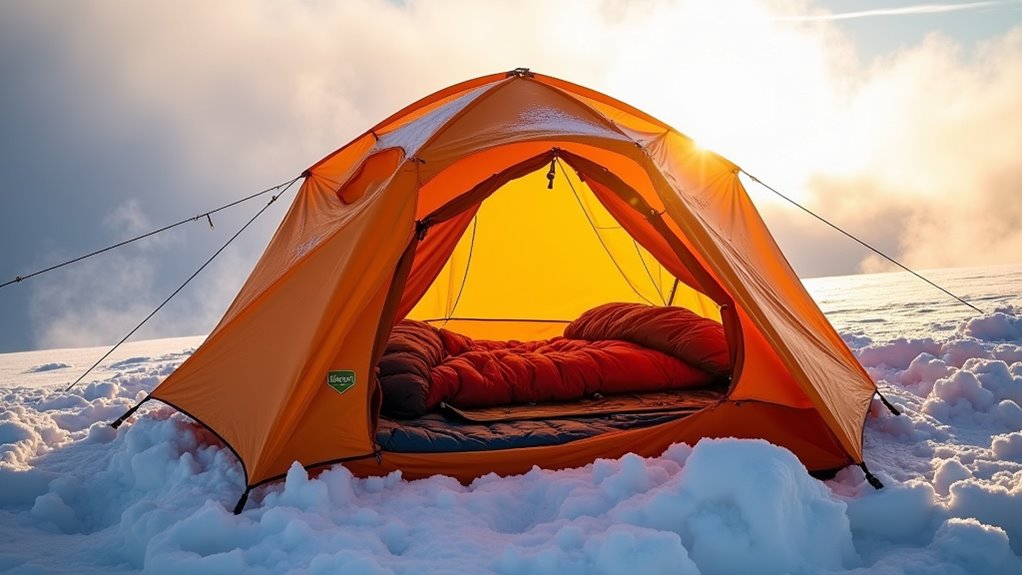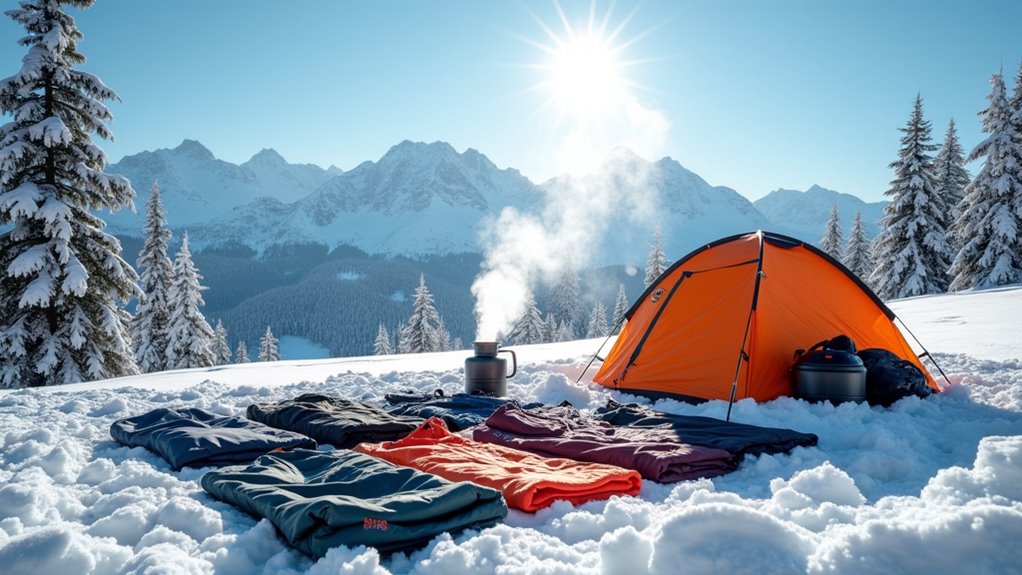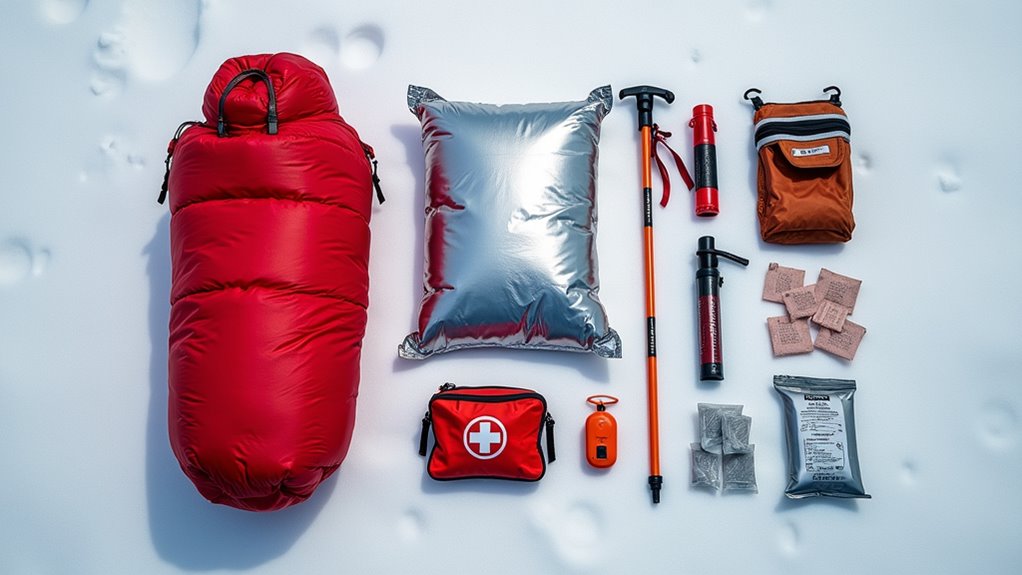Physical Address
304 North Cardinal St.
Dorchester Center, MA 02124
Physical Address
304 North Cardinal St.
Dorchester Center, MA 02124

Winter snowboarding camping demands specialized gear beyond standard equipment – discover the 8 essential items that separate epic adventures from dangerous survival situations.
You’re planning the ultimate snowboarding adventure, but camping in winter conditions isn’t your typical weekend getaway. The stakes are higher when you’re dealing with sub-zero temperatures, unpredictable weather, and backcountry terrain that can turn dangerous in minutes. Your standard camping gear won’t cut it here – you’ll need specialized equipment that could literally mean the difference between an epic trip and a survival situation. Here’s what separates prepared riders from those who learn the hard way.

When you’re planning a snowboarding camping trip, your shelter and sleep system become your lifeline against harsh winter conditions. You’ll need a four-season tent that’s specifically designed to handle snow loads and strong winds. Look for features like reinforced poles, fewer mesh panels, and a sturdy rainfly that extends close to the ground.
Your sleeping system requires three components: a cold-rated sleeping bag, insulated sleeping pad, and potentially a bivvy sack for extra warmth. Choose a sleeping bag rated at least 10-15 degrees below expected temperatures. Don’t skimp on your sleeping pad – it’s vital for insulation from frozen ground. R-values of 4 or higher work best for winter camping. Test everything together before your trip.
After setting up camp, you’ll want to prepare simple recipes that provide the energy and warmth needed for your snowboarding adventures.
Before you venture into backcountry snowboarding terrain, you’ll need essential avalanche safety gear that could save your life and the lives of your companions. Don’t compromise on these critical pieces of equipment.
Your avalanche safety kit must include:
Practice using this equipment regularly before your trip. You’ll also want avalanche education courses and current weather/avalanche condition reports for your area. Just like uphill cycling requires specific preparation and techniques, mastering avalanche safety equipment takes dedicated practice and proper planning.

Since mountain weather can shift from bitter cold to surprisingly warm within hours, mastering a three-layer clothing system becomes your key to staying comfortable and safe during multi-day snowboarding adventures.
Your base layer should be moisture-wicking merino wool or synthetic material—never cotton. Pack two sets since you’ll sweat during active days.
Your insulating mid-layer needs to trap warm air while remaining breathable; down or synthetic insulation jackets work perfectly.
For your outer shell, choose waterproof, breathable gear that blocks wind and snow while allowing moisture to escape.
Pack extra base layers, spare gloves, and wool socks in waterproof stuff sacks. Temperature swings mean you’ll constantly add or remove layers throughout the day.
This system keeps you dry, warm, and prevents dangerous overheating or hypothermia during backcountry camping. The layering strategy remains essential whether you’re hiking in cold conditions or camping for snowboarding trips.
Cold mountain air and physical exertion will burn through your energy reserves faster than you’d expect, making high-calorie foods and reliable hydration your lifeline during winter camping trips.
You’ll need calorie-dense foods that won’t freeze solid or require extensive preparation. Pack items that deliver quick energy and sustained fuel for your demanding days on the slopes.
Pack smart with foods that resist freezing while delivering the sustained energy your body craves in harsh mountain conditions.
Essential high-energy provisions include:
Don’t forget insulated water bottles to prevent freezing and maintain proper hydration throughout your adventure. Just as divers need to clear their mask underwater for optimal visibility, maintaining clear vision on the slopes requires proper preparation and the right gear to handle challenging conditions.

Winter mountain conditions can change rapidly, making reliable navigation tools and weather monitoring devices critical for your safety during backcountry snowboarding adventures.
You’ll need a GPS device with downloaded offline maps and extra batteries, since your phone’s battery drains quickly in cold temperatures. Pack a traditional compass and topographic map as backup – electronics can fail when you need them most. Include an altimeter to track elevation changes and help confirm your location.
For weather monitoring, bring a portable weather radio to receive updated forecasts and emergency alerts. A basic thermometer helps you monitor temperature drops that could signal incoming storms.
Don’t forget avalanche safety gear: beacon, probe, and shovel are essential for backcountry travel. These tools work together to keep you oriented and informed about changing mountain conditions.
Consider bringing a portable shelter option since choosing the right camping tent requires careful consideration of weather resistance and setup requirements for emergency situations in the backcountry.
When you’re camping in snowy conditions, your snowboard and gear face constant exposure to moisture, ice, and temperature fluctuations that can quickly compromise their performance. You’ll need a thorough maintenance kit to keep everything functioning properly throughout your trip.
Pack these essential maintenance items:
Essential gear maintenance items ensure your snowboard performs optimally despite harsh winter camping conditions and constant moisture exposure.
Store your maintenance kit in a waterproof container. You’ll appreciate having these tools when your board starts feeling sluggish or your bindings need adjustment mid-trip. Consider whether renting camping gear makes more sense than purchasing expensive maintenance equipment you’ll only use occasionally.

Since snowboarding accidents can happen miles from medical help, you’ll want to pack a thorough first aid kit that goes beyond basic cuts and scrapes. Include elastic bandages for sprains, instant cold packs for swelling, pain relievers, and blister treatment. Pack splinting materials like SAM splints for potential fractures. Don’t forget prescription medications and emergency contact information.
For shelter emergencies, carry a bivy sack or emergency sleeping bag rated for sub-zero temperatures. Include a compact emergency shelter like a tube tent or tarp with guy-lines. Pack an emergency whistle, headlamp with extra batteries, and waterproof matches. Chemical hand warmers can prevent frostbite during unexpected overnight situations.
Store everything in waterproof containers to guarantee functionality when you need them most. Consider organizing your first aid supplies in clearly labeled compartments so you can quickly locate critical items during high-stress emergency situations.
Beyond emergency preparedness, you’ll need reliable heating and cooking gear that performs in freezing temperatures and windy conditions. Winter camping demands equipment that won’t fail when you’re exhausted after long snowboarding sessions.
Essential portable heating and cooking equipment includes:
These items ensure you’ll stay warm and well-fed throughout your winter adventure. Implementing these warm camping strategies will help you maintain comfort and safety during your snowboarding expedition.
You’ve probably heard the theory that more gear equals better safety, but here’s the reality check: it’s your preparation and knowledge that’ll keep you alive, not just your equipment. Sure, you need quality gear, but understanding how to use each item properly matters more than having the latest model. Don’t let gear obsession replace skill development. Practice with your avalanche beacon, test your tent setup, and know your limits before heading out.